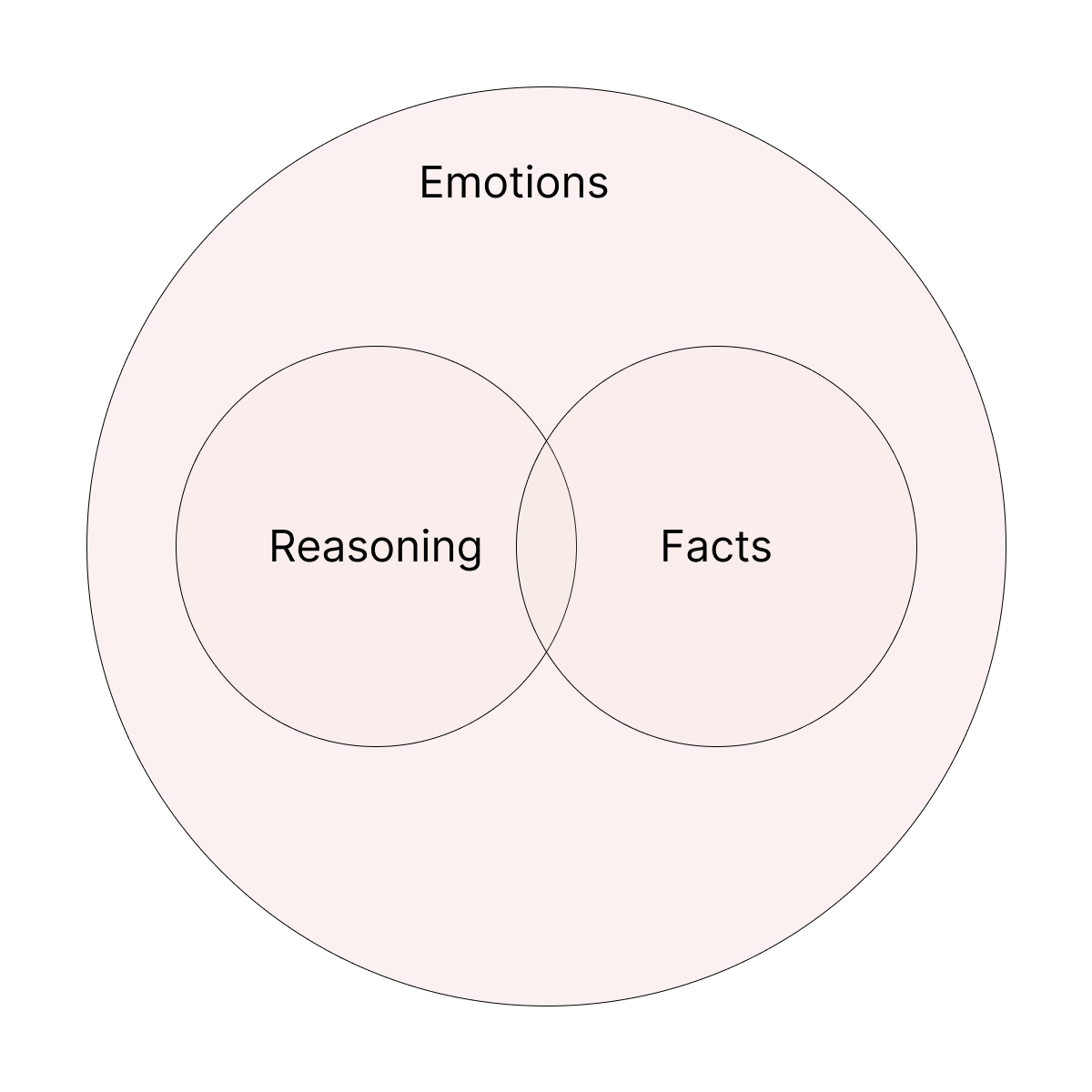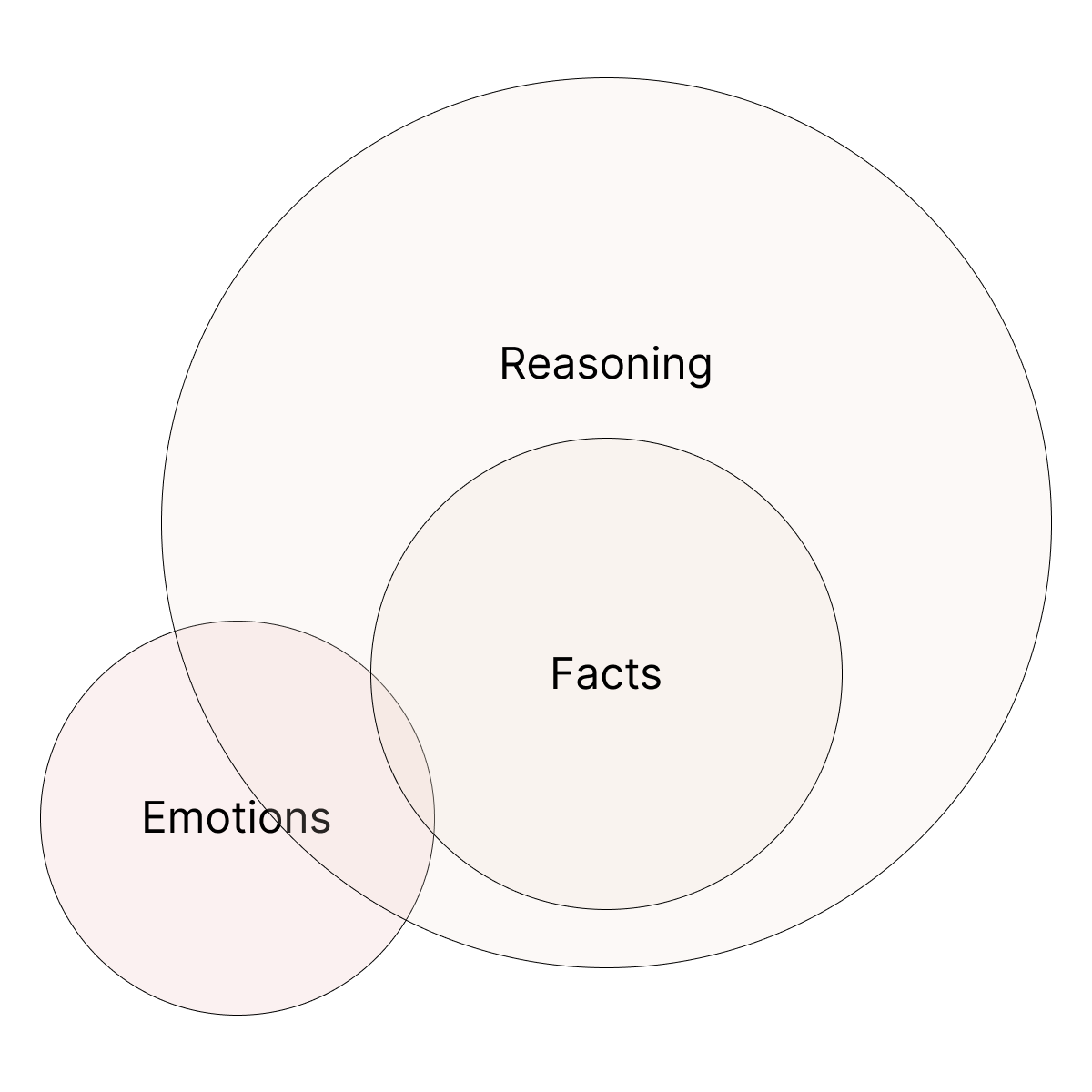

Are You sure you want to delete Member from list ?

If you don’t understand the two foundations of emotions and reasoning, you may struggle throughout your life (Brophy, Jere E., 1982). These foundations are Reasoning with Emotions and Emotional Reasoning. To grasp the first, we must also understand its counterpart. Although the terms may sound similar, there are profound differences between them. The truth lies in finding balance and developing self-awareness.
By the end of this article, I’ll share a tool that will help you measure your natural tendency toward either feelings or thinking when making decisions. Gaining this insight will empower you to make more balanced choices in life. If I still have your attention, trust me, this is about to get interesting, and you’ll discover a great deal about yourself as you read on.
Emotions lie to us all the time. They are the smoke alarms of our bodies. If you walk through grass and feel something crawling up your foot, you will jump first and only later check whether it was a grasshopper, a leaf, or a poisonous snake. This instinctive reaction is our survival system at work, making us move before we assess the situation.
The same pattern plays out in more complex situations. Our learned emotional behaviors and genetic tendencies can trigger the wrong emotions without any supporting facts. It’s like jumping before knowing what touched your foot, but on a deeper level.
This does not mean we should ignore emotions. They provide valuable information about what is happening around us. The key is to make sure the facts align with the feelings. In short, emotions are our first line of defense. And sometimes, the crawling sensation really is a snake.
So how do we know where to draw the line? To answer this, we need to dig deeper into two key concepts: Emotional Reasoning and Reasoning with Emotions.

American psychiatrist Aaron Beck first introduced the term emotional reasoning in the 1970s. It refers to or can lead to cognitive distortion in which a person assumes their emotional reaction reflects objective reality. In other words, feelings are mistaken for facts. A simple way to describe it is: “If I feel it, then it must be true.” This is classic emotional reasoning.
People with lower emotional intelligence (EQ) often fall into this pattern, believing their thoughts are facts simply because they feel them. Here, “low EQ” is not a judgment but often the result of difficult childhood experiences or challenging upbringings
Some common types of emotional reasoning that lead to cognitive distortions:
Catastrophizing
“I feel overwhelmed, so everything must be falling apart.”
A minor setback can feel like total failure.
Personalizing
“I feel guilty, so this must be my fault.”
Guilty feelings can distort how you see a situation, especially if you’ve learned to internalize blame.
Mind Reading
“I feel like they’re judging me, so I know they are.”
Often tied to social anxiety and insecurity.
Labeling
“I feel like a failure, so I must be one.”
Emotion-based identity statements that stick.
Jumping to Conclusions
“I feel uneasy, so something bad is definitely going to happen.”
A vague feeling turns into a certainty.
Magnification
“I feel anxious about that one awkward moment, so it must have ruined everything.”
Emotion blows the event out of proportion.
Filtering (Selective Abstraction)
“I feel embarrassed, so all I can remember is what I did wrong.”
You ignore the positive because your emotions zero in on the negative.
All-or-Nothing Thinking
“I feel like I failed, so nothing I did matters.”
A strong emotion turns one imperfect moment into total failure.
Source: https://brainmanager.io/blog/cognitive/emotional-reasoning

Reasoning with emotions means using feelings to guide thinking, direct attention, and prioritize what matters most in a situation. Remember the earlier example of jumping when you felt something crawling on your foot? Even if you were on an important phone call, your attention would immediately shift to the potential danger. That sudden shift shows how emotions help us prioritize.
Although there is no single standard definition, researchers describe this skill in different ways:
Using emotions to think: This involves leveraging emotions to stimulate thinking and cognitive activity, helping to prioritize what gets attention and shapes responses. (J. Kavitha Selvaranee, C. Rajan, 2023)
Using emotions as a source of information: Emotions are valuable sources of information that can be leveraged to guide thinking and behavior, not something to be suppressed. (Mayer and Salovey)
In-the-moment awareness: Successful communication involves being consciously aware of what is happening in the moment and using emotions to guide a response rather than being overcome by them.
In everyday life, situations are often more complex. To handle them well, you need conscious awareness and an understanding of your natural inclination, whether you lean more toward thinking or feeling when making decisions. This awareness allows you to use emotions as valuable information instead of being controlled by them.
Most importantly, reasoning with emotions should not be confused with intuition. The two differ in both structure and function, as the chart below illustrates.
|
Features |
Emotional Reasoning (A Cognitive Distortion) |
Reasoning with Emotions (Emotional Intelligence) |
Intuition (Rapid Pattern Recognition) |
|
Foundation |
Relies solely on current, intense feelings, assuming, "I feel it, therefore it must be true". |
Considers feelings as one piece of data, alongside logic, facts, and experience. |
Draws on accumulated subconscious knowledge and past experiences to recognize patterns. |
|
Relationship to Reality |
Distorts reality by letting the emotional state dictate beliefs, even when objective evidence suggests otherwise. |
Allows for accurate reality-checking, recognizing that emotions are not always an accurate reflection of the external situation. |
Processes information from the subconscious, which can be remarkably accurate but is not foolproof and may still carry biases. |
|
Origin |
Triggered by an intense emotional state or psychological distress, like anxiety or anger. |
Arises from a conscious and deliberate effort to be aware of and regulate one's emotions. |
Emerges as a quiet "gut feeling," hunch, or sudden insight, often without the conscious awareness of the reasoning process. |
|
Outcome |
Often leads to biased, impulsive, or irrational decisions. It can create a negative feedback loop that intensifies emotional distress. |
Leads to more balanced and rational choices. Enables greater self-awareness and improved decision-making. |
Provides quick judgments that can be valuable for swift decisions, but requires deliberate thought and analysis to check for accuracy. |
|
Associated Skills |
Associated with cognitive distortions and a habitual pattern of thinking that can worsen mental health conditions like anxiety or depression. |
A core component of emotional intelligence includes self-awareness, self-management, and empathy. |
Often linked to expertise in a specific domain, as expertise allows for more accurate and rapid pattern recognition. |
Source: Summarized by Google Gemini
Emotional reasoning treats feelings as facts, while reasoning with emotions views feelings as useful signals, not absolute truth, to guide logical thinking.
The explanations above, along with the table, highlight the difference between these two concepts. But without developing self-awareness, this knowledge alone will not take you very far. As I mentioned at the start of this article, I will now share a tool to help you build awareness of how you make decisions.
The Myers–Briggs Type Indicator (MBTI) was developed by Isabel Myers and her mother, Katherine Briggs, based on Carl Jung’s theory of Psychological Types. While it offers valuable insights that can broaden your self-understanding, it remains a theoretical model. That said, my personal experience with this test has been mostly accurate, especially in clarifying my decision-making preferences. After studying and understanding these four different dichotomies of MBTI, it widened my understanding of myself and also my empathy for others. I can see how people are different in their abilities. I am sure you will also be able to do it because of the way this test is designed.
The MBTI assesses personality across four dichotomies:
Favorite world: Extraversion (E) or Introversion (I)
Where your mind recharges.
Information processing: Sensing (S) or Intuition (N)
It’s how you process and collect information from the world.
Decision-making: Thinking (T) or Feeling (F)
The way you are making decisions
Lifestyle preference: Judging (J) or Perceiving (P)
Dealing with the world
For today’s topic on reasoning and emotions, our focus is on decision-making. Some people naturally lean toward thinking: they rationalize, analyze, and reason through almost everything. Others are more inclined toward feeling: they rely on emotions to guide their choices.
I recommend taking the following test to explore your own preferences. Keep in mind, there are no right or wrong answers. Simply choose the options that feel most accurate for you without overthinking. It works best when it taps into your subconscious patterns.
One of the best MBTI tests: https://www.idrlabs.com/test.php
Feel free to share your results, either as a screenshot or in writing. I’d love to provide my insights into your type and how it connects with your decision-making style.